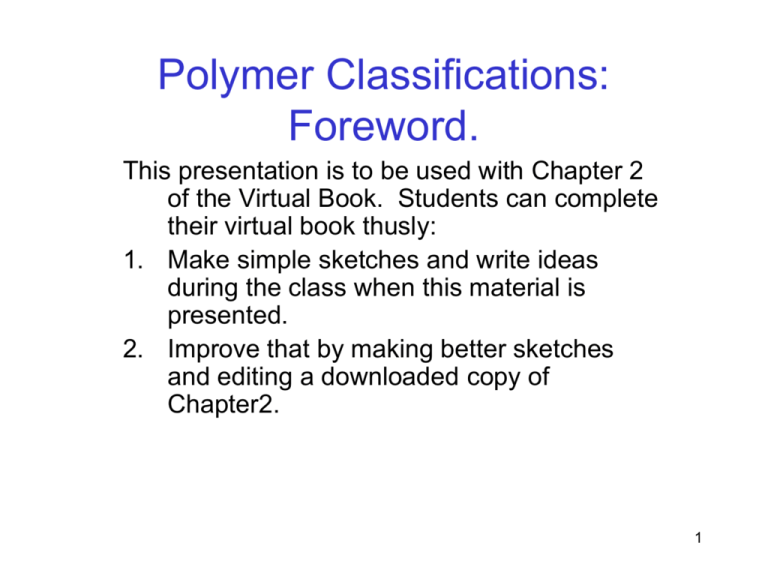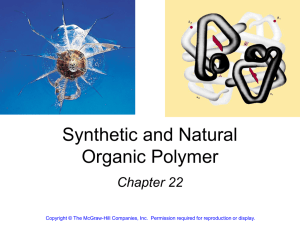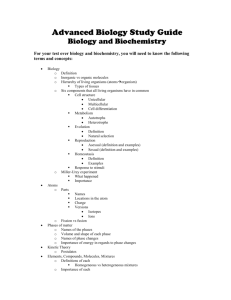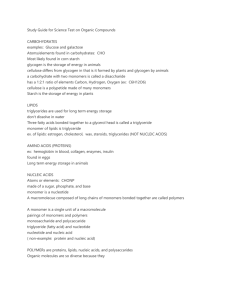Polymer Classifications - LSU Macromolecular Studies Group
advertisement

Polymer Classifications: Foreword. This presentation is to be used with Chapter 2 of the Virtual Book. Students can complete their virtual book thusly: 1. Make simple sketches and write ideas during the class when this material is presented. 2. Improve that by making better sketches and editing a downloaded copy of Chapter2. 1 Linear polymers can be represented by a simple sequence such as: A-A-A-A-A CH . CH2 Polystyrene n Styrene monomer Nylon Two monomers make one repeating unit.* HOOC COOH H2N-(CH2)6-NH2 Nylon monomer Nylon 6,6 *There many different kinds of nylon. 2 Polydispersity is the term we use to describe the fact that not all macromolecules in a given sample have the same “repeat number” x. Polydisperse # # size Paucidisperse Monodisperse # size size Even in a pure sample, not all molecules will be the same. Nature often does better than people do. 3 Addition Condensation Chain growth Step growth Example Polystyrene Nylon Empirical formula No change from monomer. Changes as byproduct (often water) is given off. How grows One monomer at a time Monomer + dimer, hexamer + octadecamer, etc. Polydispersity Can be paucidisperse “Most probable” Molecular weight Wide range: can be very high Low (except biopolymers) Synonym Chain growth polymerization Step growth polymerization 4 Addition: one monomer at a time Also called chain growth. Condensation: anything goes! Also called step growth. 5 The molecular weight of condensation (step growth) polymers is limited to fairly low values. Why? Condensations: usually < 50,000 g/mol Addition: can be quite high (e.g., 46 x 106 for polystyrene) Convert that to tons/mol Nature makes huge polycondensates, but they are usually made in chain growth fashion! 6 There are such things as inorganic polymers. R’ --[P=N]-x R R used to be a secret. Not sure if it still is. Others: POSS, poly(phthalocyanines), many colloids (colloids are close relatives of polymers) 7 Cascade polymers are also known as dendrimers. This remains one of the hottest areas of macromolecular science. Co-invented at LSU, it is still practiced here. (McCarley, Warner, Daly, Russo) Newkome @ LSU Tomalia @ Dow Future Nobelists? Tomalia: now at MMI Newkome: now at U. Akron 8 The poly(phenylene) dendrimer at left has actually been crystallized (Mullen). The arborol dendrimer below was made by Newkome at LSU….and we still make this one at LSU. 9 Copolymers can be used to tailor functionality or generate new phases and behaviors. Block copolymer, example: Poly(styrene)-block-poly(butadiene) Random copolymer, example: Poly(styrene-ran-butadiene) Graft copolymer, example: Poly(styrene)-graftpoly(butadiene)10 Some chemists really care about nomenclature. Type Connective Example unspecified -co- poly(Aco-B) statistical -stat- poly(Astat-B) random -ran- poly(Aran-B) alternating -alt- poly(Aalt-B) periodic -per- poly(Aper-Bper-C) block -block- polyAblockpolyB graft -graft- polyAgraftpolyB James Traynham—LSU, 2003 From the Chemistry at U. Missouri Rolla website 11 What does that mean? Star polymers have the ability to act a little bit like spheres and you can get higher M’s. f=4 A lot of the magic of polymers is just size. Suppose each of the 4 “arms” is polydisperse. Are such molecules more or less polydisperse than their linear counterparts? Each “arm” of this star is a “random coil”. Star rods would be fun. 12 Letter polymers are synthetically challenging and useful for testing theories. From the Mays website In Hartford, Hereford and Hampshire, H’s Hardly Happen* •In Knoxville, Tennessee (home of Jimmy Mays) they do. •Matters in polyolefins—makes for better processing? Regular letter polymers help manufacturers defend billion dollar patents. *Adapted from the musical, “My Fair Lady” 13 Combs, brushes and ladders give you ways to stiffen a polymer. Think “bottle brush” 14 Rodlike polymers are used for very high strength, liquid crystals, photonics, efficient viscosification and control of phase relations. Rodlike because of linear backbone N N * n S S Used in stealth bomber? Maybe. Rodlike because of helix 15 * Polyelectrolytes: strange things happen when you try to separate charges by a few Angstroms. Strong polyelectrolytes (e.g., salts of strong polyacids or polybases) Do they still tell you about Angstroms? Sodium polystyrene sulfonate: fully charged, yet behavior depends on added salt Monomer: SO3Na CH3 Weak polyelectrolytes (e.g., weak polyacids or polybases) Poly(acrylic acid) Behavior depends on added salt and pH Monomer: CH2=CH-COOH One of the hottest areas of fundamental polymer research involves polyelectrolytes. Concentration of charge along a backbone, with charged groups closely separated, produces 16 some weird distortions in the molecules…and in the surrounding solution. Opposites may repel! You are made of biopolymers. R group varies one unit to the next H O N n H R 17 Proteins can do almost anything. Proteins are the most amazing molecules on Earth, large or small. They have 4 levels of structure, which can confer enormously high function. In particular, they make excellent catalysts—you are all “burning” fuel now…at 37oC….efficiently compared to most human-designed combustion devices! It’s the proteins that do this. They also give structure and strength and resilience. They can change their shape—the original “smart molecule”. 18 The 4 levels of structure • Primary: the sequence of the amino acids • Secondary: helix, coil or random sheet (and a few others) • Tertiary: folding of the unit, including –S-S- bridges • Quaternary: how the blobs assemble 19 Structure = Function More Structure = More Function http://www.sciencecollege.co.uk/SC/biochemicals/bsheet.gif Alpha helix Beta sheet http://www.search.com/reference/Alpha_helix Protein Normal synthetic polymer Subunit a Subunit b http://www.biosci.ohio-state.edu/~prg/protein1.gif a-Helical secondary structure S-S link 20 b-sheet secondary structure There are 20 common, naturally occurring amino acids. Name ALIPHATIC Alanine Valine Leucine Isoleucine Formula 3-letter Symbol Ala Val Leu -CH3 -CH(CH3)2 CH2CH(CH3)2 CH(CH3)Ile C2H5 Simplified Symbol A V L I NONPOLAR Glycine Proline Cysteine Methionine H XXX -CH2SH -C2H4-S-CH3 Gly Pro Cys Met G P C M AROMATIC Histidine Phenylalanine Tyrosine Tryptophan XXX -CH2- -CH2--OH XXX His Phe Tyr Trp H F Y W POLAR Asparagine Glutamine Serine Threonine CH2CONH2 C2H4CONH2 CH2OH CH(OH)CH3 Asn Gln Ser Thr N Q S T CHARGED Lysine Arginine Aspartate Glutamate -C4H8NH3+ XXX CH2COOC2H4COO- Lys Arg Asp Glu K R B E http://www.genome.iastate.edu/edu/gene/genetic-code.html#Amino21 Acids Another type of biopolymer, nucleic acids, contains the information needed to make proteins. Borrowed from Natural Toxins Research Center Webpage: http://ntri.tamuk.edu/cell/nucleic.html An interesting sub-section of the nanotech community tries 22 to use nucleic acids as structural materials. Biopolymers: Nucleic Acids Ribose sugar Base OH 3' O H O ..... H N H3C O P O O OH O P O OH O U N O H2C N H N N O N OH N O H2C G N N OH O CH2 O G N H ........ N C N OH N NH ......... O O NH2 O O P O O N OH NH N OH N O A H2C NH2 O O O P O OH RNA N C O P O O N C N ..... H N G O O N OH N O OH CH2 O N ........ H N T H N H .. O O P O OH CH3 N OH O P O H2C O O A N N O H2C N CH2 O N N O .... H N H P O O H N H ..... O N OH O P O P O O N CH2 O H2C A H O ... H N OH CH2 O O O O P O OH O N N O H2C O O O P O T N H ...... N O 5' O P O O 3' O P O O O 5' DNA 23 Nucleic acids code proteins, a molecular “build sheet” • Nucleic acids are how we get (or “code”) proteins. There are 4 bases (called A,T,G,C). Three of these in a row gives a "codon" which tells the cellular machinery to add a particular amino acid. Nucleic acids are much less prevalent than proteins, in the same sense that auto factories are less prevalent than automobiles. They make interesting model polymers for a variety of studies—from better understanding of polymer flexibility to liquid crystal behavior. • You can get a list of the codons for the various amino acids at: http://www.genome.iastate.edu/edu/gene/geneticcode.html#Amino Acids 24 Networks (Gels) combine the properties of liquids and solids. Keep on branching. The ultimate molecule: M = The Gentrys Sing Keep on High-speed Jello Video CLICK IT! High-Speed Jello Video CLICK IT! Branching (or something like that) CLICK FOR SONG! Pathetic Cover of Keep on Branching by Boy Band Bay City Rollers CLICK FOR SONG! High-Speed Jello Video CLICK IT! It only takes a little polymer (a few percent by weight) to turn the water to a nominal solid, and the polymers in gelatin are held by noncovalent forces. Making the network for a tire involves significantly more polymer and covalent forces are involved. 25 Thermoplastic/Thermoset is another big distinction. Macromolecular chemistry involves chemists, biologists, physicists, and various engineers. The engineers, just like average citizens, have very little use for a molecular point of view. They tend to divide the polymer world into thermoplastic and thermoset “resins”. • Thermoplastic: when you heat it, it flows (e.g., polyethylene, polystyrene) • Thermoset: when you heat it, it “sets up” into a solid (e.g., epoxy glue, styrene monomer) 26 Silica-Polypeptide Composite Particles Paul S. Russo (Louisiana State University), DMR-Award #1005707 We assist the Chemical Educational Foundation’s You Be the Chemist Challenge program, a middle school “quiz bowl” that impacts ~16,000 students in 22 states. This year, we have focused on vetting the thousands of questions it takes to operate Challenge. To give Challenge a more “hands-on” and “real-world” flavor, the Louisiana champion, Hayden Day, studied from a new Louisiana Playbook we are designing (see sample question below and figure at left). Louisiana YBTC Playbook, Problem #25. The sequence of pictures at left shows the repair of the polymeric skin of an automobile bumper which was torn during a wreck. The repair consists of pushing the parts together closely, holding them with tape on the outside (red) part, and “welding” them on the inside (black) side using a soldering iron. ↑Grad student Javoris Hollingsworth teaches 8th-grader Hayden Day, the 2012 Question 1: Is the bumper a thermoset or a Louisiana state champion in the Chemical Educational Foundation’s You Be the thermoplastic? Challenge, about titrations. Barely Question 2: Suppose instead of a torn bumper Chemist visible in the background is Hayden’s we had a gashed tire made from vulcanized Mom, a school teacher. Hayden’s father, a chemical plant technician, is looking on rubber. Would heating a vulcanized rubber too. Dad studied every day with his son, repair the tire? and Hayden acquitted himself well in the national competition in Philadelphia in Question 3: Explain how polymer welding June. works at a molecular level. Polymers can be amorphous, crystalline, or a bit of both—corresponding to brittle, gooey and tough (oversimplified!). Polymers can be solid without crystalline structures. These are called glasses. Polymers can be crystalline (amazing). Most useful polymers a little bit of both— regions in the material have crystalline inclusions and other regions are amorphous. These materials are often tough—the amorphous regions absorb shock. 28 Transitions We deal with this later, but even from the outset you should know a little bit. Glass transition is the temperature BELOW which the amorphous regions of a sample start to act like solids. Melting transition is the temperature ABOVE which the crystalline regions of a sample start to act like fluids. Either way, these are oversimplifications—big molecules have a number of transitions that describe the chain mobility. These molecular transitions, in turn, impact the physical properties—from “feel” to “stickiness” (tack) to elongation and breakage. 29








